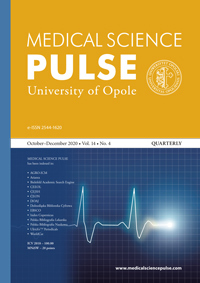Selected risk factors for ischemic heart disease and the success of treatment in patients with STEMI myocardial infarction treated with percutaneous coronary intervention.
Selected risk factors for ischemic heart disease and the success of treatment in patients with STEMI myocardial infarction treated with percutaneous coronary intervention.
Author(s): Marzena Jędrzejczyk-Cwanek, Piotr Jerzy Gurowiec, Dorota OzgaSubject(s): Health and medicine and law
Published by: Uniwersytet Opolski
Keywords: myocardial infarction; risk factors; ischemic heart disease
Summary/Abstract: Background: Coronary heart disease is one of the most common causes of hospitalization and premature deaths in Europe. ST-segment elevation myocardial infarction (STEMI) has been a clinical problem for many years, particularly in the aspect of choosing the optimal treatment method. The success of treatment is determined by many factors, including risk factors for ischemic heart disease, time between onset of symptoms and initiation of treatment, number and degree of coronary stenosis, and many more. Aim of the study: The aim of the study was to identify risk factors for ischemic heart disease affecting the success of STEMI patients treated with percutaneous coronary intervention (PCI). Material and methods: A retrospective analysis was carried out on data from medical records of patients treated in the Department of Acute Coronary Syndromes of St. Hedvig Provincial Hospital No. 2 in Rzeszow between 2009 and 2014. The research tool used in this paper was the author’s questionnaire. A total of 508 patients with STEMI myocardial infarction treated in the Department of Acute Coronary Syndromes (ACS) between 2009 and 2013 were included in the analysis. The inclusion criteria were the complete and clear files of patient treatment in the ACS department between 2009 and 2013 due to acute coronary syndrome treated invasively by the PCI method. Results: Majority of the study group, 334 subjects, (65.7%) had hypertension. The most common risk factors for ischemic heart disease were found to be dyslipidemia in 176 subjects (34.6%) and smoking in 163 subjects (32.1%). This paper presents the results of the analysis of the success of treatment in relation to risk factors for ischemic heart disease. There was a statistically significant relationship between hypertension and successful treatment (p=0.0425). More cases in which treatment was unsuccessful were observed in the group of patients who had no previous treatment for lipid disorders (20.2% vs. 4.0%) (p = 0.0000). Significantly more cases of treatment failure were found among people who denied smoking (17.4% vs. 8.6%; p = 0.0087). Conclusions: Among the analyzed behavioral and somatic risk factors for failure in patients subjected to treatment were untreated hypertension, hyperlipidemia and a negative history of cigarette smoking.
Journal: Medical Science Pulse
- Issue Year: 14/2020
- Issue No: 3
- Page Range: 49-54
- Page Count: 6
- Language: English

